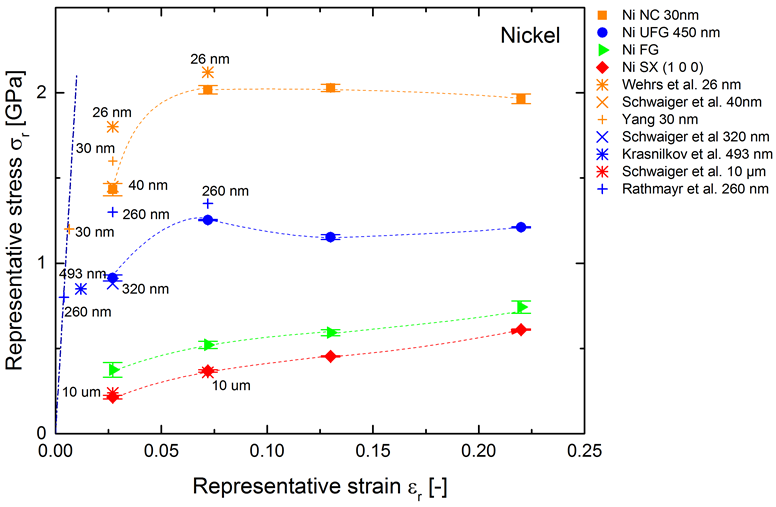Project Leader: Daniel Kiener
For the design of modern high-performance materials small-scale effects are frequently utilized. Consequently, structure dimensions are decreased down to the micron- or even nanometer-scale making conventional testing techniques often inappropriate to fundamentally characterize these materials. Miniaturization, fabrication at a laboratory bench scale, but also cost-effectiveness are further determining factors which need to be considered for the development of novel testing methods. Hence, new techniques to assess the material flow behavior should comply with following requirements:
- Straightforward sample preparation
- Minimum consumption of material
- Maximum exploitation of data
Nanoindentation is a promising candidate to meet these needs and is available in almost any modern material research lab. Even though the technique is widely used to reliably determine hardness and Young’s modulus of various materials, there is still a great potential to further exploit instrumented indentation data. Understanding the small-scale deformation processes and effects during indentation is the key to further advance nanoindentation methods. Therefore, this project is dedicated to the enhancement of existing methods, but also to the development of novel approaches to open new fields of applications and to make nanoindentation a testing technique of first choice. Main objectives are:
- Deepen the understanding of dynamic nanoindentation techniques (see ref. [1])
- Extraction of flow behavior using self-similar pyramidal tip geometries (see ref. [2])
- Evaluation of indentation size effects on flow curve characteristics (see ref. [2])
- Establishment of new calibration procedures for spherical non-self-similar tip geometries
- Development of methods that ensure constant strain-rate experiments using spherical tips
- Confirmation and refinement of results using Finite Element Methods (FEM)
- Extension of these aspects to high-temperature applications (see ref. [3])
So far, discrepancies between static and dynamic tests have been noted. Within this project, this effect has been investigated and it could be demonstrated that differences mainly arise from strain-rate changes during the static protocol which must be implicitly considered in the nanoindentation analysis. In particular the determination of flow curves from nanoindentation is of great interest, even though the multiaxial stress state underneath an indent complicates the analysis. Using pyramidal self-similar tips allows to obtain stress values at discrete equivalent strains. As an example, a set of residual imprints for different tips taken to the same indentation depth are shown below.
Based on the determined hardness and the related imposed strain, we could demonstrate for various face and body centered cubic metals that nanoindentation flow curves obtained by such a multiple sharp tip approach coincidence well with macroscopic uniaxial tests once the indentation size effect is considered.
An alternative approach to enable the determination of a continuous flow curve with one single impression is the combination of spherical tips and a dynamic loading protocol. However, tip imperfections are a great challenge, hence new calibration procedures for spherical tips are introduced, alike constant strain-rate methods which ultimately leads to excellent agreement between nanoindentation and uniaxial flow curves. Ongoing FEM models will be used to confirm the new findings and to give estimates on the impact of deviating tip shapes and creep effects.


